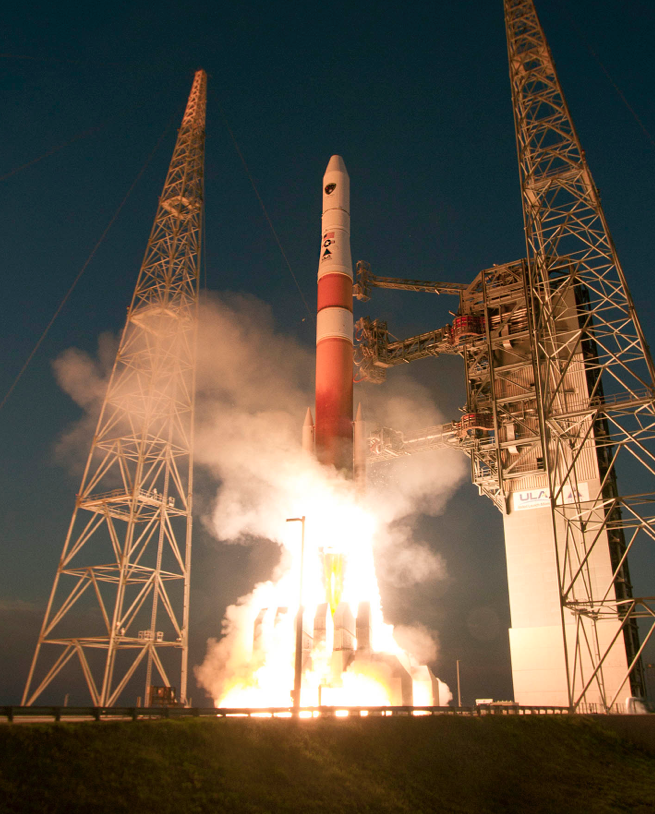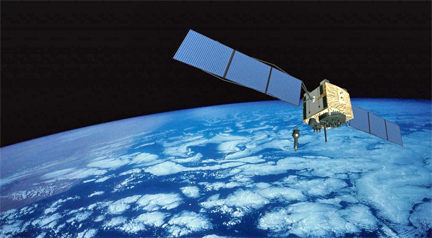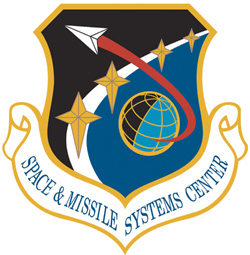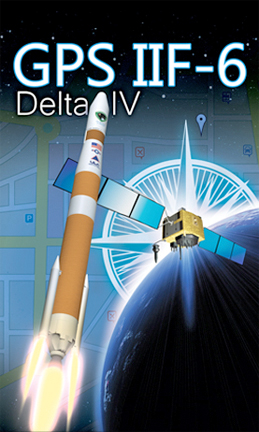
Cape Canaveral Air Force Station, Fla. (May 16, 2014) – A United Launch Alliance (ULA) Delta IV rocket successfully launched the sixth Global Positioning System (GPS) IIF-6 satellite for the U.S. Air Force at 8:03 p.m. EDT today from Space Launch Complex-37. This is ULA’s fifth launch in 2014, and the 82nd successful launch since the company was formed in December 2006. GPS IIF-6 is the sixth in a series of next generation GPS satellites and will join a worldwide timing and navigation system utilizing 24 satellites in six different planes, with a minimum of four satellites per plane positioned in orbit approximately 11,000 miles above the Earth’s surface. The GPS IIF series provides improved accuracy and enhanced performance for GPS users. Photo Credit: United Launch Alliance
[SatNews] At 8:03 p.m., local time, at Cape Canaveral Air Force Station, a United Launch Alliance Delta IV rocket lifted off, carrying the U.S.A.F.'s sixth Block IIF GPS satellite to orbit.
This launch followed a 24 hour hold, due to inclement weather. This launch is actually the halfway mark for this series of satellites, prior to the 3gen GPS satellites coming online in 2016.
Statement from ULA
Cape Canaveral Air Force Station, Fla., (May 16, 2014) – A United Launch Alliance (ULA) Delta IV rocket successfully launched the sixth Global Positioning System (GPS) IIF-6 satellite for the U.S. Air Force at 8:03 p.m. EDT today from Space Launch Complex-37. This is ULA’s fifth launch in 2014, and the 82nd successful launch since the company was formed in December 2006.
“ULA is honored to work with this world-class U.S. government and contractor mission team, and we are proud to contribute to the GPS capabilities that were delivered to orbit today,” said Jim Sponnick, ULA vice president, Atlas and Delta Programs. “Congratulations to the entire team on tonight’s successful launch of the GPS IIF-6 satellite and the continued one-launch-at-a-time focus.”
This mission was launched aboard a Delta IV Medium-plus configuration Evolved Expendable Launch Vehicle (EELV) using a single ULA common booster core powered by an Aerojet Rocketdyne RS-68 main engine, along with two ATK GEM-60 solid rocket motors. The upper stage was powered by an Aerojet Rocketdyne RL10B-2 engine with the satellite encapsulated in a four-meter-diameter composite payload fairing.
ULA's next launch is the Atlas V NROL-33 mission for the National Reconnaissance Office scheduled for May 22 from Space Launch Complex-41 at Cape Canaveral Air Force Station, Florida.

Artistic rendition of a GPS IIF satellite.
Image courtesy of Boeing.
GPS IIF-6 is the sixth in a series of next generation GPS satellites and will join a worldwide timing and navigation system utilizing 24 satellites in six different planes, with a minimum of four satellites per plane positioned in orbit approximately 11,000 miles above the Earth’s surface. The GPS IIF series provides improved accuracy and enhanced performance for GPS users.

The EELV program was established by the United States Air Force to provide assured access to space for Department of Defense and other government payloads. The commercially developed EELV program supports the full range of government mission requirements, while delivering on schedule and providing significant cost savings over the heritage launch systems.
With more than a century of combined heritage, United Launch Alliance is the nation’s most experienced and reliable launch service provider. ULA has successfully delivered more than 80 satellites to orbit that provide critical capabilities for troops in the field, aid meteorologists in tracking severe weather, enable personal device-based GPS navigation and unlock the mysteries of our solar system. Reliable launch, real-world benefits.
For more information on ULA, visit the ULA website at www.ulalaunch.com
Statement from U.S. Air Force
LOS ANGELES AIR FORCE BASE, El Segundo, California—The U. S. Air Force successfully launched the sixth Global Positioning System (GPS) IIF satellite carried aboard a United Launch Alliance Delta IV launch vehicle at 8:03 EDT from Cape Canaveral Air Force Station, Florida, May 16.
The Boeing-built GPS IIF satellite joins the GPS constellation providing global coverage and increased overall performance to users around the globe. The GPS IIF satellite provides greater navigational accuracy through improvements in atomic clock technology, a more resilient signal for commercial aviation and safety-of-life applications and a longer design life of 12 years.
"Today's successful launch demonstrates our combined government and industry team's dedication to mission success, ensuring GPS continues to be the Gold Standard for space based positioning, navigation, and timing," said Col. Bill Cooley, director of the Space and Missile Systems Centers Global Positioning Systems Directorate. "I want to recognize the tireless efforts of the 45th and 50th Space wings, United Launch Alliance, Boeing, and the GPS IIF and Delta IV program teams at SMC. I am extremely proud of the team, everyone pulled together to make this day a true success. Users can depend on GPS with confidence today, tomorrow and in the future."
GPS provides accurate real time position, navigation and timing services and plays a major role in information resources supporting a variety of civil, scientific and commercial functions on land, sea and air. Operated by U.S. Air Force Space Command, the GPS constellation provides precise services worldwide 24-hours a day, and the Air force is committed to providing improved capabilities to ensure users around the globe receive the maximum benefits provided by GPS.
GPS has led to greatly enhanced farming, survey/mapping, telecommunications, banking and other financial transactions. It supports more efficient electrical power distribution, internet service, mass transit, and recreational activities. GPS has improved the understanding of our environment to include climate change, endangered species tracking, earthquakes and volcanoes. It is also vital to first responders in emergencies and disaster relief operations worldwide. Additional uses include monitoring sea level changes, engineering surveys and scientific applications that require precise position determination.
The Air Force Space Command's Space and Missile Systems Center, located at Los Angeles Air Force Base, California, is the U.S. Air Force's center of acquisition excellence for acquiring and developing military space systems. Its portfolio includes the Global Positioning System, military satellite communications, defense meteorological satellites, space launch and range systems, satellite control networks, space based infrared systems and space situational awareness capabilities.
End Statement
The GPS IIF satellites weigh in about around 3,530lbs (1,630kg) and possess a design life of approximately 12 years. These satellites have all been redesigned and/or updated to make certain all capabilities have been improved—this deployment mission has been named after the star named Rigel in the Orion constellation... the brightest star in that constellation.

"The 45th and 50th Space wings, United Launch Alliance, Boeing, and the GPS IIF and Delta IV program teams at SMC are working together to make this a successful launch," said Col. Bill Cooley, director of the Space and Missile Systems Center's Global Positioning Systems Directorate.
The satellite marks the second launch of a GPS satellite this year and the sixth of 12 GPS IIF satellites. The first five GPS IIF satellites are currently on-orbit and meeting all mission requirements. Of the remaining seven still to be launched, one is being prepared for launch, one is being prepared for shipment to Cape Canaveral AFS, four are in storage and one is completing production. The Boeing built GPS IIF satellites provide vital support to users while adding a new civil signal (L5) for commercial aviation and safety-of-life applications, improved navigational accuracy through advanced atomic clocks, and a longer design life than its predecessor.
"The GPS constellation is reliably serving global users with the most accurate and robust signals ever, and the navigation, timing accuracy and availability will improve as the GPS modernization efforts continue," said Col. Cooley. "GPS is the most widely used and accepted system of its kind in the world today, and we stand ready to launch GPS IIF-6."
While GPS is a military-procured and operated satellite constellation, it is recognized as a global utility. The typical GPS user has a receiver in their phone or in their car; however, GPS has become more than a system to help users get from point A to point B; it also plays an important role in everything from aiding disaster relief operations to making electrical power distribution more efficient. The agriculture community relies on GPS signals for precise positioning to optimize use of seeds, fertilizer and water.
The United States provides this precise position, navigation and timing service free of charge to billions of users around the globe. The Air Force Space Command's Space and Missile Systems Center, located at Los Angeles Air Force Base, California, is the U.S. Air Force's center of acquisition excellence for acquiring and developing military space systems. Its portfolio includes the Global Positioning System, military satellite communications, defense meteorological satellites, space launch and range systems, satellite control networks, space based infrared systems and space situational awareness capabilities.

